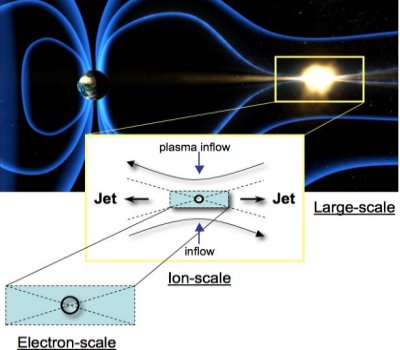A leap forward in probing magnetic reconnection in space
12 March 2007
Magnetic reconnection is a fundamental physical process in the Universe, playing a major role in various phenomena such as star formation or solar explosions, but also preventing plasma confinement in fusion reactors on Earth. However, a lack of precise measurements at the heart of this physical process prevents a full understanding of this phenomenon. High-resolution data from the 4 satellites of the ESA/NASA Cluster mission have enabled, for the first time, the derivation of a new physical quantity, which improves our understanding of the role of the electric field in this process. |
| Image 1. Reconnecting magnetic field lines forming an X-line |
Magnetic reconnection is a universal phenomenon in space far from being fully understood. It is in particular responsible for powerful explosions on the Sun called solar flares. These explosions can trigger the release of massive amounts of hot plasma towards Earth that affect or even permanently damage satellites. This physical process is also one of the most efficient mechanisms to enable solar material to enter the Earth's magnetic environment or magnetosphere. On the nightside of the magnetosphere or magnetotail, magnetic reconnection heats local plasma and hurls it at hundreds of kilometres per second in the form of plasma jets towards Earth, at a location somewhere between a third and half the distance to the Moon. These jets of energetic particles cause colourful auroras but can also perturb the ionosphere, disrupting critical technology systems used on Earth such as GPS signal or radio communication.
These examples are just a few among the many macroscopic consequences of magnetic reconnection. However, while it can affect large volumes of plasma in space, this mechanism occurs within very localised regions called diffusion regions. In the Earth's magnetotail, these regions are less than a few hundred kilometres wide. This is a very small size when compared to the width of the magnetotail itself in the same region (~300 000 km). In other words, understanding the microphysics of magnetic reconnection is key to understand and later predict its macroscopic consequences.
| Animation 1. Cluster observes a reconnection event |
At the heart of the reconnection process, magnetic field lines from different magnetic domains collide and tie together, changing the overall magnetic field topology, usually forming an X-line [Animation 1 and Image 1]. This topology change leads to the mixing of previously separated plasmas like the entry of solar material into the magnetosphere. It also efficiently converts magnetic field energy to particle energy, generating plasma heating and reconnection jets as in the magnetotail. But the magnetic field is not the only physical parameter to consider. As we will see, the electric field also plays a crucial role in the microphysics of reconnection.
The electric field is fundamentally linked to the magnetic field: whenever there is magnetic field B, there is an electric field E linked to it, almost everywhere oriented perpendicularly to B. However, at the heart of the reconnection process, the electric field has a component parallel to the magnetic field which controls in particular the acceleration of particles. The perpendicular component causes plasma and magnetic field inflow towards the X-line, necessary for reconnection to occur. This electric field component is known as the "reconnection electric field".
The electric field is governed by the generalised Ohm's law which decomposes E into the sum of four terms:
| E = | Large-scale term | + | (1) |
| Medium-scale term | + | ||
| Microscopic term 1 | + | ||
| Microscopic term 2 |
Here is a brief description of these terms with respect to magnetic reconnection:
- Large-scale term
Name: Ideal MagnetoHydroDynamics (MHD) term Brief description: Dominates other terms at large distances from a reconnection site Measured in space: Yes
- Medium-scale term
Name: Hall term Brief description: Becomes important in the ion diffusion region, at distances hundreds of kilometres from a reconnection site in the magnetotail Measured in space: Yes
- Microscopic term 1
Name: Divergence of the electron pressure tensor Brief description: Might contribute significantly to the generation of the reconnection electric field in a small region around and at the reconnection site called the electron diffusion region, for example at distances less than ~5 km from the reconnection site Measured in space: Not previously
- Microscopic term 2
Name: Electron inertia term or anomalous resistivity Brief description: Might contribute significantly to the generation of the reconnection electric field in the electron diffusion region; generally induced by plasma turbulence Measured in space: No
 |
| Image 2. The different scales relevant to the magnetic reconnection process |
Numerical simulations [e.g. Hesse et al., 1999] suggested that the first electron-scale term (Microscopic term 1) supports the reconnection electric field. However, no full derivation of this physical quantity from satellite measurements has been achieved up today. The divergence of the electron pressure tensor quantity requires in particular very accurate particle measurements simultaneously by multiple satellites.
On 17 August 2003, the four satellites of the ESA/NASA Cluster mission were flying in tetrahedron formation in the magnetotail, with an average inter-spacecraft separation of only 200 km. Data from the electron (PEACE), ion (CIS) and magnetic field (FGM) instruments clearly suggest that a reconnection site moved past the spacecraft location in the tailwards direction, associated with a magnetic substorm. Cluster spacecraft do not sample directly either diffusion region but are magnetically connected to an ion diffusion region.
"After considerable efforts by the PEACE team to perfect the PEACE calibration, the multi-spacecraft nature of the Cluster mission was used to derive the first measurements of the divergence of the full electron pressure tensor", says Paul Henderson, PhD student at the Mullard Space Science Laboratory/University College of London (UK), lead author of these results, published 29 November 2006 in Geophysical Research Letters.
Thanks to this work, Paul Henderson and co-authors were able to directly compare quantitatively, for the first time, this quantity (first microscopic term in equation 1) to the Hall term (medium scale term in equation 1). In agreement with simulations, they found in particular that both terms generate oppositely directed electric field contributions, clearly anti-correlated.
"This observational first by Cluster is a leap forward in probing magnetic reconnection. I am even more delighted to see such a scientific discovery led by a PhD student. More than 40 PhD/Master thesis based on Cluster and Double Star data have been defended since 2003, of which 31 are PhDs and counting", says Philippe Escoubet, Cluster and Double Star project scientist of the European Space Agency.
P. D. Henderson, C.J. Owen, A.D. Lahiff, I.V. Alexeev, A.N. Fazakerley, E. Lucek, and H. Rème, Cluster PEACE observations of electron pressure tensor divergence in the magnetotail, Geophysical Research Letters, 33, L22106, doi: 10.1029/2006GL0278868, 2006.
Contact
Main author
Paul Henderson, Mullard Space Science Laboratory, University College London, Dorking, UK
Email: pdh mssl.ucl.ac.uk
mssl.ucl.ac.uk
Phone: +44-1483-204-184
Web story author and co-editor
Arnaud Masson, SCI-SO division, RSSD, ESA, The Netherlands
Email: Arnaud.Masson esa.int
esa.int
Phone: +31-71-565-5634
Web story editors
Philippe Escoubet, SCI-SM division RSSD, ESA, The Netherlands
Email: Philippe.Escoubet esa.int
esa.int
Phone: +31-71-565-4564
Matthew Taylor, SCI-SO division, RSSD, ESA, The Netherlands
Email: Matthew.Taylor esa.int
esa.int
Phone: +31-71-565-8009


